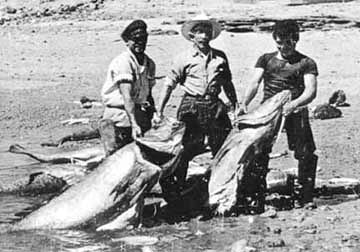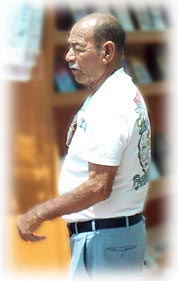|
One of San Felipe's most recognizable
patriarchs died last night (Dec. 18, 2009). Tony Reyes
was a fishing legend in these parts and familiar to anyone
in the last few generations who have sport fished in the
area.
Always amiable, with an elfin sense
of humor, Tony was well-loved by everyone and will be
missed. He had been suffering from kidney problems for
some time.
* * * * *
This profile of Tony Reyes
was written by Chuck Garrison and appeared in the December
2005 edition of Western
Outdoors:
Barely pushing five feet tall and
weighing-in at plus-or-minus 150 pounds, Tony Reyes nevertheless
represents a towering giant of south-of-the-border sportfishing.

Tony Reyes (left), Gorgonio "Papa"
Fernandez (center), and Chi Chi Fernandez with gigantic
totuava nearing 300 pounds in weight, Bahía
Gonzaga, c. 1954. |
While his physical stature is diminutive,
his reputation among anglers on both sides of an international
border is colossal. Antonio Reyes Vaca, Sr. or simply
"Tony" Reyes, has most likely, more than any
man alive, introduced generations of saltwater anglers
to a span of fish-laden Mexican waters stretching a couple
of hundred miles from San Felipe, a fishing port on Baja's
eastern coast in the extreme northern reaches of the Sea
of Cortez, south to Baja's rock-and-cacti-strewn Midriff
Islands region.
And speaking of longevity, the
ever-affable, always smiling Reyes, born June 13, 1923,
knows a lot about staying alive; he's been living large
now for 82 years. If he experiences the same protracted
lifespan as his mother - a stalwart woman whose physical
stamina and mental makeup met the task of raising13 children
alone - well, Señor Tony Reyes has a lot more living
to do. His mother died at 113.
These days a physically limited
Reyes, hands and fingers gnarled by arthritis, serves
as his own goodwill ambassador for a boat that's his namesake,
the 107-foot, steel-hulled Tony Reyes. The vessel represents
a multi-day, ruggedly formatted sportfishing business
based out of San Felipe's small commercial harbor. Her
trips seek - and most often find - a variety of game fish
inhabiting the Midriff Islands region of Baja's Gulf of
California. Among sites visited are las Islas de Encantado,
Isla de la Guardia, Isla Partida, Raza, Salsipuedes, Las
Animas, San Lorenzo and Bahia de San Francisquito. Among
catches scored are yellowtail, a catch-all classification
of cabrilla, spotted bass, white seabass, big-as-a-bathtub
giant sea bass, several types of grouper, aggressive jumbo
squid and, in warmwater water cycles, yellowfin tuna and
dorado.
Today, it's Reyes' son Tony Jr.
who now skippers the converted-shrimpboat Tony Reyes,
while the elder Reyes routinely remains ashore in San
Felipe, overseeing the business and bookings through The
Longfin tackle store in Orange, California; greeting legions
of annually returning fishing friends, coordinating boat
maintenance and supplies. Yet each spring he still manages
to attend the popular Southern California Fred Hall fishing
tackle shows where he's the patriarchal star, swapping
fish tales in The Longfin-Tony Reyes Fishing Tours exhibit
booth.
And if such fish tales were regulated
by number, Tony Reyes would surely have overlimits. He's
seen huge predatory fish herd and bulldoze baitfish right
up on a sudsy, damp beach, sending water and sand into
the air; watched as a skiff angler was pulled overboard
when a surging grouper took advantage of a rolling boat
and a hammered-down drag; seen a tiger shark so huge brought
ashore off San Francisquito Bay that the gill-netters
who snared it could only guess its weight at more than
four tons. The tiger - a documented, aggressive man-eater
- measured nearly 20 feet long and had a set of nightmarish,
teeth-infested jaws that could easily have swallowed a
man past his shoulders.
Many anglers would agree that
Tony is best known for all the many years he guided, promoted
and became the bandana-browed icon of six-day Midriff
Islands trips aboard a pudgy, bowed, shrimper-turned-rudimentary
sportfisher: the Santa Monica. Serving as a mother ship
and piggybacking several skiffs or pangas aboard, the
Santa Monica's accommodations, were (and still are) lacking
many of the luxuries of San Diego's modem multi-day fishing
fleet. Still, the Midriff excursions of the 1950s caught
on rapidly with an emerging Baja angler-adventurer persona
which would unflinchingly swap minimal comforts for maximum
rod bending. In short, Midriff trips nurtured a sort of
John Wayne angling machismo, a Robinson Crusoe lifestyle
and a Bogart African Queen cruising experience.
Yet even before Antonio Reyes Vaca was emerging as a true
northern Baja fishing pioneer - and long before the celebrated
Hollywoodite Ray Caimon scribed accolades about Baja's
raw beauty and boundless angling in his best-selling Sunset
Book, The Sea of Cortez - Tony Reyes arrived in San Felipe
and was drawn himself into a love affair with la mar.
"I was born into poverty
in Mexico City and by the time I came to San Felipe in
1951, I'd already worked different jobs as a peasant child:
making toilet seats, bricks, candles, sweaters, furniture,
propane and sugar cane containers, you name it,"
Reyes told this writer last year during a trip to San
Felipe. "I even went to Vera Cruz for a while and
helped build a banana boat.
"Then, in 1945 there was
a manpower shortage in the US because of the [World] War,
so I went north and worked as a bracero in the fields.
I went wherever the work called - Minnesota, North Dakota,
Wyoming - ending up in the farmlands of Fresno, San Jose,
Azusa and Covina in California."
In 1950, Reyes' undocumented worker-status
rendered him deported by INS officials, landing him in
Tijuana, where he slept on the beach, begged money for
food and desperately sought work. Then a friend who'd
crewed aboard San Diego's then-bustling commercial tuna
boat fleet told Tony that a few Americans were "just
starting to find out about the great sportfishing out
of San Felipe, especially for a particularly large fish,
a cousin to the white seabass, called the totoaba."
So Reyes moved to San Felipe and
quickly took a job as a deckhand on a commercial shrimper,
the dubiously-named Dopey, and began to learn about fishing
and the sea.
 "I
didn't make much money," he recalled. "I was
paid mostly in seafood - fish and shrimp, and a few pesos." "I
didn't make much money," he recalled. "I was
paid mostly in seafood - fish and shrimp, and a few pesos."
During the off-season for shrimping,
Tony worked across the Baja peninsula in the emerging
Ensenada sportfishing fleet. In 1951, his first off-season
in Ensenada, he helped repair and paint the party boat
Gaviota I. By the next year he was a deckhand among the
Ensenada party boat fleet.
Yet his roots drew him back to
San Felipe where in 1953 he started taking angler-tourists
out locally to catch corvina, white seabass, Sierra (cero
mackerel), yellowfin croaker and those monstrous totoaba
(sometimes called totuava).
"I started out buying an
old, used, 12-foot skiff that would barely hold two anglers,
and me," Reyes reflected. "I didn't have an
outboard motor, so I rowed four miles each way."
One of Tony’s early clients,
so impressed with Reyes’ work ethic and prowess
as a fishing guide, bought a small outboard motor in the
states, delivered it to San Felipe and allowed Tony to
make monthly payments.
Sometimes the totoaba caught were
so large that the 150-pound-plus fish wouldn't fit in
the little boat; they would have to be secured by rope
and towed back to shore. (It's
interesting to note that several sources - both personally
related accounts and printed references - vary greatly
in describing sizes the eventually nearly fished-out totoaba
attained. Reyes said he's seen catches up to about 180
pounds, while a book source claimed an enthusiastically
estimated 440-pounder as the largest ever taken. Further,
an old Los Angeles newspaper fishing column reported "250pounders
being not uncommon." Yet a check with the International
Game Fish Association revealed not a single line-class,
world record listed for either "totoaba" or
"totuava." Apparently, anglers in the 1940-50s
totoaba heydays never submitted world-record applicatlons
for any catches.)
Slowly but steadily, Tony Reyes
built up his own fleet of small pangas and guides, established
a base camp at Okie's Landing near Isla Lobos (said to
have been named after anglers who hooked and lost big
fish, because they kiddingly "fished like Oklahoma
farmers") and advanced his reputation as a rise-early,
fish-hard, return-late guide who made his first priorities
equal: fish catches and customer service.
Reyes' big break came in the late
1950s when one of his fishing clients, Dave Fink, then
owner of Davey's Locker Sportfishing in Newport Harbor,
Southern California, suggested to Tony that he start running
three and five-day trips southward to fish the little-pressured
Baja coast and some of the upper Midriff Islands. The
idea was intriguing to Reyes, who first rented local shrimpboats
to make the trips, before eventually buying one himself
and making basic vessel conversions for sportfshing.
The timing for the longer trips
couldn't have been better. While totoaba catches skyrocketed
in the early 1940s, as commercial fishermen set gill nets
and even detonated dynamite across the totoaba's Colorado
River spawning routes as a robust wholesale market developed
for the fish, the bonanza was short-lived. In 1942, commercial
catches hit 2261 tons, but by 1975, the last year before
the nearly extinct totoaba were protected by a fishing
ban, catches had plummeted to a paltry 58 tons.
Fortunately, Tony Reyes wasn't
affected by the demise of the San Felipe totoaba sportfishery,
because he had long before established himself as the
pioneer of the Midriff's multi-day fishing fleet.
|